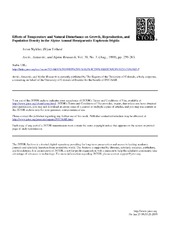Effects of temperature and natural disturbance on growth, reproduction, and population density in the alpine annual hemiparasite euphrasia frigida
Peer reviewed, Journal article
Permanent lenke
http://hdl.handle.net/1956/2561Utgivelsesdato
1999Metadata
Vis full innførselSamlinger
Sammendrag
The effects of temperature and "natural disturbance" on growth, seed production, and population density in the facultative hemiparasitic annual Euphrasia frigida (Scrophulariaceae) were examined in the middle alpine zone at Finse, southwest Norway. Experimentally elevated temperature increased growth and seed production significantly. Higher temperatures resulted in a small decrease in population densities during three seasons. The degree of "natural disturbance" did not influence growth and seed production, but population density was highest at intermediate disturbance levels. Thus, while temperature influenced the performance of E. frigida, disturbance affected the population dynamics. The effects of temperature on growth and reproduction may also be indirect on hemiparasites, through improved conditions for the host plants under elevated temperatures. It is hypothesized that the predicted global warming will result in increased seed output from E. frigida plants in the middle alpine zone. Population densities, however, are likely to decrease under elevated temperatures, due to lower disturbance levels by frost heave and increased vegetation cover
